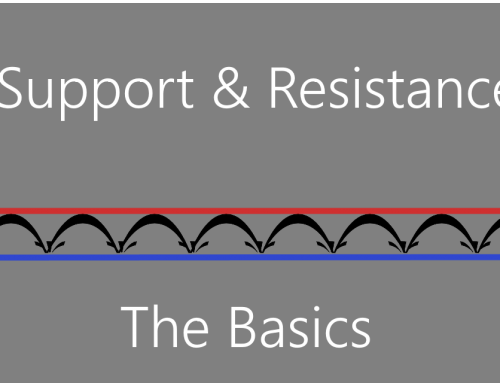Most traders have found that getting into a trade is a lot easier than getting out with a profit. It’s clear that properly timing the exit out of a trade is often the only difference between making and losing money.
Since planning an exit is a crucial part of any trade, let’s look at some of the basic methods for getting out of a trade successfully and consider a few of the variables involved.
First, let’s look at an example of what often happens if a trader, we’ll call him Joe, goes into a trade without a good plan to exit the stock. Joe says, “I entered just as the stock broke above resistance and before I knew it I was up 3 bucks on the trade; but then I wasn’t sure what to do. I watched the stock bounce around for a week and now I’m down 2 dollars.”
Obviously something went wrong with the trade.
When did Joe make a mistake?
A) When he didn’t take the profits when they were available?
B) When he didn’t sell when it pulled back to his entry?
C) When he didn’t set a stop?
D) When he didn’t plan his exit before entering the trade?
The answer is “D.” Different traders use different exit strategies, but the most important factor is that a trader must have an exit plan before he/she enters the trade.
Traders use a variety of exit strategies. Below we’ll discuss a few of them: Stops, Limit Orders Near Resistance, and Selling at Certain Percentage Gains. We’ll also look at the role that the Market Environment plays in making the decision. In this discussion, we will concentrate on long trades, but the same concepts hold true for short trades.
Using Stops and Trailing Stops
At RightLine, we are convinced that in almost every circumstance, the best method to exit a position is to be “stopped out.” Sure, if we knew when a stock was peaking, it’d be better to put in a limit or market order at the peak. But the reality is we don’t know exactly what will happen tomorrow so we suggest traders set a stop when they initially enter the position, and then trail it higher as the stock moves ahead. Using stops almost always eliminates the chance of the big loss at the same time that it lets profits run. During times of serious bull runs, this method is great because it works well on stocks that continue to break out. When the momentum shifts, then traders are stopped out somewhere just below the highs and they protect their capital so they can re-enter again when the stock begins to move up again.
There are a couple of drawbacks to using stops. First, during choppy times traders can get stopped out of the trade on intra-day volatility before the stock moves higher. Second, setting and trailing your stocks takes time and requires consistent review. In our opinion, the benefits far outweigh the drawbacks and we believe that most serious traders should be using stops to exit their trades.
Sell Limit Orders Near Resistance
Sometimes stocks will trade in a range where the support is strong at one price level and the resistance is strong at another price level. A stock might be in an upward or downward trend and trading in a channel where both the trend line of support and the trend line of resistance look strong. Some traders enter a long position as the stock bounces up from support and then place a limit order to sell just below the resistance level. This concept is based on the idea that trading within the normal movement of the stock can provide a reduced-risk trade.
At RightLine, we think this approach is good, but can be improved by using stops and adjusting the “tightness” of the stops depending on where the stock is in the channel. For example, after entering the trade and setting the initial stop, we encourage tightening the stop as the stock approaches known resistance levels. Then if the stock moves right through resistance, you won’t miss the powerful breakout that normally accompanies a break through resistance. On the other hand, if the stock bounces back down from resistance, you only lose a small amount of your profits. The small downside risk is worth the upside potential in most cases.
Selling at a Target Price or Percentage Gain
Some traders watch for a stock to reach a certain “target price” level before selling. If the stock is at 50 and they believe it will go to 60, then they buy the stock and eventually put in a limit order to sell at 60. This approach isn’t very time consuming, and for certain types of stocks it may make sense, but for other types of stocks it can be a big mistake. Intermediate to longer-term traders tend to use this method. The downside of the method is that it ignores many of the technical aspects of trading. Furthermore, since most brokers don’t allow two sell orders to be in place at one time, traders can’t place both a limit order to sell at the target price and a stop order to protect against a decline. Traders using this approach need to keep an eye on the stock’s movement to know when to change from a limit order to a stop order.
Market Environment
Before planning your exit, look at the market environment. While we recognize that it’s impossible to perfectly forecast what the market will do, we do feel that there are times when the general direction of the market appears clear. When the market is choppy, traders may want to lean toward accepting smaller gains, using tighter stops and expecting shorter holding periods. On the other hand, when the market is hitting on all cylinders, consider looking for bigger gains, using looser stops and generally holding stocks longer.
The market often dictates what types of exit strategies are worth considering, but more often than not, we like the use of setting an initial stop and then trailing the stop higher. This method is great if the market is consistently pushing stocks to breakout and works well if stocks are trading in a channel as traders enter on a bounce off support and tighten stops near the top of the channel.
We feel that our method of exiting stocks is one of the most crucial reasons that our readers continue to be successful, even during difficult markets. Regardless of which exit strategy you choose, make your plan and stick with it.






